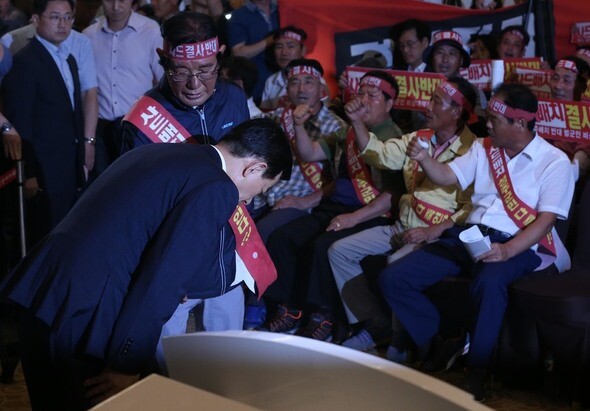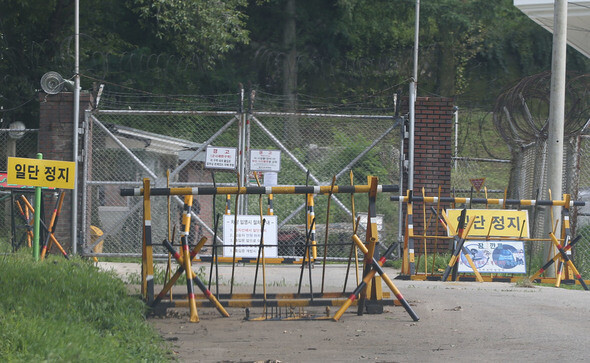hankyoreh
Links to other country sites 다른 나라 사이트 링크
THAAD location formally announced, and won’t protect the Seoul area

On July 13, South Korea’s Ministry of National Defense announced that Seongju County in North Gyeongsang Province had been chosen as the site for the THAAD missile defense system. Deploying THAAD in Seongju means Seoul and its suburbs will fall outside of THAAD’s defense range, while most of the key US military installations will fall inside it. This is likely to strengthen suspicions that the real motivation for deploying THAAD is to protect US forces in South Korea.
“The joint US-ROK task force proposed Seongju County in North Gyeongsang Province as the ideal place to deploy THAAD in terms of maximizing military utility, guaranteeing the safety of locals and not affecting public health or the environment. Both South Korea’s Defense Minister and the US Secretary of Defense have signed off on the plan,” said Ryu Jae-seung, head of the Ministry of Defense‘s policy office, in the Ministry’s briefing room on Wednesday.
“The goal is to deploy THAAD by the end of next year, but we will redouble our efforts so that we can deploy it even faster,” Ryu said.

The selection of the site where THAAD will be deployed came just five days after South Korea and the US announced their decision to deploy the missile defense system in South Korea on July 8 and only five months after the two sides initiated official deliberations about deployment in February.
Ryu explained that THAAD could provide protection from North Korean nuclear weapons and missiles for people living in an area that covered between one-half and two-thirds of South Korea, for important national facilities such as nuclear reactors and oil storage facilities and for US-ROK alliance forces.
Seoul and its suburbs were omitted from THAAD‘s mission since they are too close to the DMZ for the system to be able to effectively prevent North Korean ballistic missiles from hitting them.
The northern limit of THAAD’s reported maximum range of 200km extends to just north of Pyeongtaek. This means that, as long as USFK does not deploy its single THAAD battery further north, Seoul and most of the capital region - where half of South Korea’s population and key national infrastructure are concentrated - will be excluded from THAAD’s scope of defense.
In contrast, the majority of US military installations - including those at Pyeongtaek, Osan, Gunsan, Daegu and Chilgok - are within a 200km radius of Seongju. This area also includes ROK military facilities, including the Gyeryongdae military complex where the headquarters of the ROK army, navy and air force are clustered. The bulk of the South Korean military, however, is positioned near the border with North Korea.

This may provoke speculation and criticism that the decision to deploy THAAD in Seongju was originally made with the intent of protecting US military assets in South Korea.
Some politicians are expressing skepticism about whether a weapon system that is inherently limited in its ability to intercept North Korean ballistic missiles should be brought into South Korea, given the ensuing diplomatic and military strain with China and Russia, which could cause a major rupture in the strategic terrain of Northeast Asia.
“What are we supposed to think about a decision to include US military installations in THAAD’s protective range while excluding the capital area with its population of 25 million people? THAAD is being deployed not for the Korean people but for the American army,” said Son Geum-ju, senior spokesperson for the opposition People’s Party, in a statement released on Wednesday.
“Now they keep trying to deploy THAAD even though it won’t protect the capital area. This is different from what they were telling the public until now,” said Rep. Lee Chun-seok, a lawmaker with the opposition Minjoo Party of Korea, in a telephone interview with the Hankyoreh.
It turns out that the Defense Ministry had ruled out the capital area as a possible deployment site all along.
“We considered a dozen or so places as candidates for deploying THAAD, but Pyeongtaek in Gyeonggi Province, Wonju in Gangwon Province, Eumseong in North Chungcheong Province and Chilgok in North Gyeongsang Province were never selected as candidates,” said Ryu. He said that those areas near the capital were never even considered, which had been a subject of rumors.
The implication is that the Ministry had already concluded that THAAD was not suitable for providing air defense for the capital area.
In “Report to Congress on Theater Missile Defense Architecture Options for the Asia-Pacific Region,” which the US Department of Defense prepared at the request of Congress in May 1999, analysts concluded that “in the case of the THAAD-like endo-exo upper tier system, the high endo minimum intercept altitude would preclude engagements for threats attacking the northern portions of the ROK.” The “northern portions” mentioned here include the DMZ and Seoul, which is nearby.
The fact that planners concluded so early on that THAAD could not defend the capital area makes it very likely that the US was behind the push to deploy THAAD on the Korean Peninsula. The South Korean military must have been loath to provoke diplomatic controversy by deploying a weapon system that does not even protect the capital region, given the domestic importance of Seoul and its suburbs.
Diplomatic and military conflict with China and possible harm to economic cooperation are both major concerns for South Korea. But for the US, THAAD has the advantage of protecting US military assets on the Korean Peninsula and defending Daegu and other major military bases where American reinforcements would assemble in the event of war. Another likely boon for the US is that THAAD will drive a wedge between South Korea and China and prevent South Korea from cozying up to China.
“China firmly opposes the deployment of THAAD in the ROK and strongly urges the US and the ROK to halt the process. China will take all necessary measures to safeguard its interests,” said Chinese Foreign Ministry Spokesperson Lu Kang during the regular press briefing on Wednesday.
By Park Byong-su, senior staff writer, Song Kyung-hwa, staff reporter and Kim Oi-hyun, Beijing correspondent
Please direct questions or comments to [english@hani.co.kr]

Editorial・opinion
![[Column] Park Geun-hye déjà vu in Yoon Suk-yeol [Column] Park Geun-hye déjà vu in Yoon Suk-yeol](https://flexible.img.hani.co.kr/flexible/normal/500/300/imgdb/original/2024/0424/651713945113788.jpg) [Column] Park Geun-hye déjà vu in Yoon Suk-yeol
[Column] Park Geun-hye déjà vu in Yoon Suk-yeol![[Editorial] New weight of N. Korea’s nuclear threats makes dialogue all the more urgent [Editorial] New weight of N. Korea’s nuclear threats makes dialogue all the more urgent](https://flexible.img.hani.co.kr/flexible/normal/500/300/imgdb/original/2024/0424/7317139454662664.jpg) [Editorial] New weight of N. Korea’s nuclear threats makes dialogue all the more urgent
[Editorial] New weight of N. Korea’s nuclear threats makes dialogue all the more urgent- [Guest essay] The real reason Korea’s new right wants to dub Rhee a founding father
- [Column] ‘Choson’: Is it time we start referring to N. Korea in its own terms?
- [Editorial] Japan’s rewriting of history with Korea has gone too far
- [Column] The president’s questionable capacity for dialogue
- [Column] Are chaebol firms just pizza pies for families to divvy up as they please?
- [Column] Has Korea, too, crossed the Rubicon on China?
- [Correspondent’s column] In Japan’s alliance with US, echoes of its past alliances with UK
- [Editorial] Does Yoon think the Korean public is wrong?
Most viewed articles
- 1‘We must say no’: Seoul defense chief on Korean, USFK involvement in hypothetical Taiwan crisis
- 2N. Korean delegation’s trip to Iran shows how Pyongyang is leveraging ties with Moscow
- 3‘Weddingflation’ breaks the bank for Korean couples-to-be
- 4Korea sees more deaths than births for 52nd consecutive month in February
- 546% of cases of violence against women in Korea perpetrated by intimate partner, study finds
- 6Will NewJeans end up collateral damage in internal feud at K-pop juggernaut Hybe?
- 7[Column] Park Geun-hye déjà vu in Yoon Suk-yeol
- 8[Editorial] New weight of N. Korea’s nuclear threats makes dialogue all the more urgent
- 9Amnesty notes ‘erosion’ of freedom of expression in Korea in annual human rights report
- 10“Parental care contracts” increasingly common in South Korea